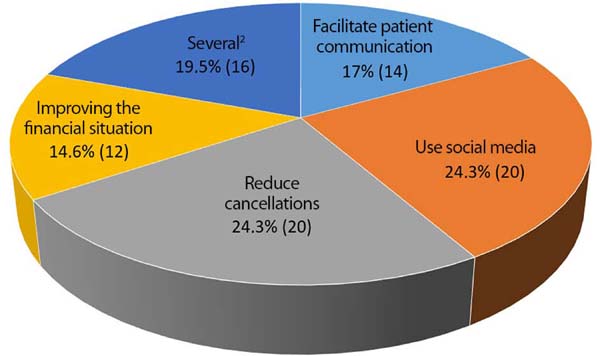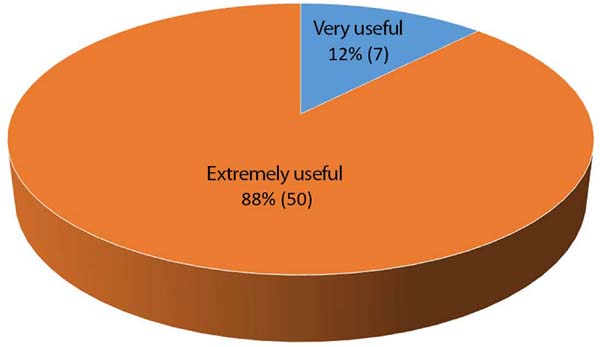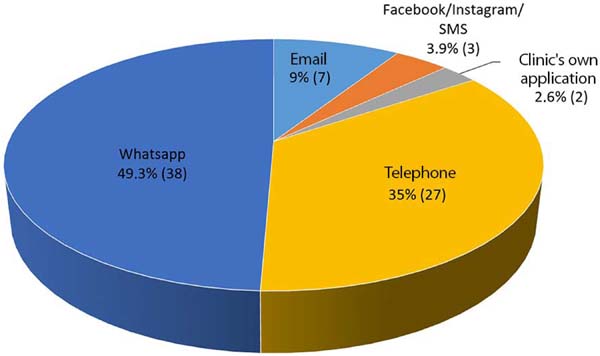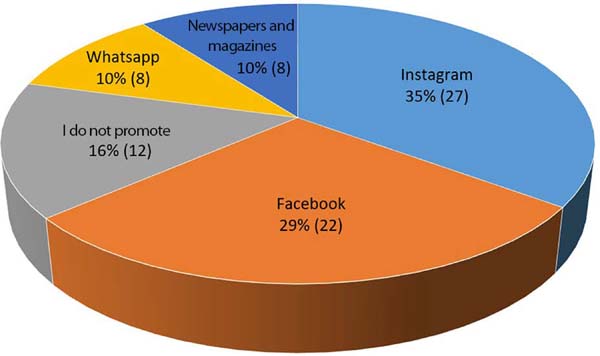

Original Article - Year 2020 - Volume 35 -
Use of digital mobile applications and their integration in plastic surgery
Uso de aplicativos digitais móveis e sua integração em cirurgia plástica
ABSTRACT
Introduction: In the environment of new digital health
technologies, many paradigms are being broken, and the
opening to obtain further knowledge allows the plastic surgeon
to use them in their professional practice. This article aims to
analyze the use of digital mobile applications by patients and
professionals. The purpose is to understand the importance
and recognition of this type of technology to provide more
quality and safety in medical care, specifically for elective
care in the plastic surgery specialty.
Methods: Two analysis
were carried out, in parallel, in a retrospective and descriptive
manner: 1) of the conversations carried out through a mobile
instant messaging application on the communication channel
for monitoring patients undergoing surgery in a private plastic
surgery clinic; (2) of the use of digital technologies in plastic
surgery, through the analysis of the responses to a research
questionnaire sent to professionals in this specialty.
Results: In the sample obtained (n = 61), the monthly average of 122
conversations in the postoperative period was recorded. In a
satisfaction survey, patients found it useful to communicate
through a mobile application directly with the clinic. Only
4.1% of the professionals who participated in the research
had their own clinic application.
Conclusion: The perception
of the importance of technology in patient care, the need to
meet the population's requirements, and the possibility of
providing more comprehensive monitoring reliably offer the
basis for validating new technology resources and mobile
applications with specific resources in plastic surgery care.
Keywords: Mobile applications; Technology; Plastic surgery; Appointment scheduling; Patient safety.
RESUMO
Introdução: No ambiente de novas tecnologias digitais em saúde, muitos paradigmas estão sendo rompidos e a abertura para obter novos conhecimentos permite ao cirurgião plástico usá-las na sua prática profissional. O presente artigo propõe-se a analisar a utilização de aplicativos digitais móveis, por pacientes e profissionais, visando entender a importância e o reconhecimento desse tipo de tecnologia no sentido de proporcionar maior qualidade e segurança nos atendimentos médicos, especificamente para atendimentos eletivos da especialidade cirurgia plástica.
Métodos: Foram realizadas duas análises, em paralelo, de maneira retrospectiva e descritiva: 1) das conversas realizadas através de um aplicativo móvel de mensagens instantâneas no canal de comunicação destinado ao acompanhamento de pacientes submetidos a cirurgias em uma clínica privada de cirurgia plástica; (2) da utilização de tecnologias digitais em cirurgia plástica, através da análise das respostas de um questionário de pesquisa enviado aos profissionais dessa especialidade.
Resultados: Na amostra obtida (n=61), registrou-se a média mensal de 122 conversas no pós-operatório. Em pesquisa de satisfação, os pacientes consideraram útil ter um meio de comunicação através de aplicativo de celular diretamente com a clínica. Somente 4,1% dos profissionais que participaram da pesquisa dispunham de um aplicativo próprio da sua clínica.
Conclusão: A percepção da importância da tecnologia na assistência dos pacientes, a necessidade de atender os requerimentos da população e a possibilidade de proporcionar um acompanhamento mais abrangente, de forma confiável, fornecem embasamento para validar novos recursos de tecnologia, aplicativos móveis com recursos específicos no atendimento de cirurgia plástica.
Palavras-chave: Descritores: Aplicativos móveis; Tecnologia; Cirurgia plástica; Agendamento de consultas; Segurança do paciente
INTRODUCTION
An increasing number of professionals from other specialties have been practicing techniques previously exclusive to plastic surgeons. Assisted by technological media, they end up becoming a kind of “reference” for laypeople, who are unaware of the risks of carrying out invasive procedures without due technical support. The plastic surgeon who respects the ethical standards performing his medical advertising actions within the legal norms adopted by the regulatory councils, 1 ends up losing credibility and suffering the consequences because he cannot follow the growth of services provided on the internet, social media, and mobile apps2.
In this environment created by the emergence of new digital health technologies, many paradigms are being broken. The opening to obtain further knowledge allows the plastic surgeon to become familiar, versatile, and comfortable with social media, using them for future commercial actions and growth in practice professional3. However, little is explored in the information regarding the use of medical applications to monitor patients.
OBJECTIVE
This article aims to analyze the use of digital mobile applications by patients and professionals to understand the importance and recognition of this type of technology to provide more quality and safety in medical care, specifically for elective care in the plastic surgery specialty.
METHODS
This is descriptive and retrospective research that carried out two analyses: (1) of the conversations on an instant messaging application on the communication channel for monitoring patients undergoing surgeries in a private clinic of the author, from January to March 2019. (2) The use of digital technologies in plastic surgery, through the analysis of a research questionnaire’s answers sent to professionals.
1st Analysis:
During the period analyzed, 61 patients of both sexes, aged between 18 and 60, held conversations through the application for three consecutive months.
On the day they scheduled the surgery, the patients received requests for preoperative exams and a printed material containing guidelines for performing the procedure. The material was also about post-operative care and the respective informed consent form for the surgery. Besides, they became aware of the main means of contacting the medical team, including the cell phone number available for permanent assistance, by voice call, text messages, or by instant messaging application (WhatsApp®).
After undergoing surgical procedures, patients routinely received phone calls and/or messages at the end of the day that they were discharged from the hospital and, subsequently, as required by the case. The basic questions established by the assistant team involved subjective analyzes of the general condition, such as pain, discomfort, difficulty breathing, swelling, and appearance in the operated region, also emphasizing to the patients the possibility of subsequent contact, through telephone calls or a mobile messaging application. In any clinical or surgical manifestation that required medical participation, the responsible professional was informed about taking the necessary measures and determining the appropriate conduct.
• The variables analyzed in the conversations conducted through the instant messaging application on the communication channel intended for monitoring patients were:
• Information about recovery after surgery;
• Reasons for contact through the messaging application;
• The average time elapsed between the surgery and the sending of messages by the patient.
• Subsequently, a satisfaction survey was carried out, which was to assess the care provided by the team and the use of the mobile application in the patient’s postoperative recovery.
Satisfaction survey:
a) Service of staff: (1) bad; (2) regular; (3) good; (4) great.
b) Use of the mobile application for postoperative recovery: (1) extremely useful; (2) very useful; (3) indifferent; (4) unnecessary.
2nd Analysis
Access links to the Google Forms platform were sent to 273 professionals in the specialty of the southern region of Brazil in July and August 2019. The questionnaire contained four questions:
• What are the most used means of communication for patient contact?
• What are the main problems faced in day-to-day practice?
• Which attitudes do you consider important to improve the performance of the office or clinic?
• What are the means of communication currently used for professional dissemination?
The data obtained in the research with patients (1) and professionals (2) were analyzed using the SPSS Statistics for Windows (version 16.0). Descriptive analysis of the study variables was performed; for categorical variables, the absolute frequencies (N) and relative frequencies (%) were calculated. The results were presented in the form of graphs.
The analysis followed the principles of Helsinki (2000) and resolution 466/2012 of the National Health Council that deals with the ethical and legal aspects of research involving human beings in Brazil4.
RESULTS
zIn the sample obtained for the study (n = 61), an average of 7.4 conversations was recorded using the messaging/patient/month application (minimum: 1; maximum: 18). Among the messages received in the analyzed period, the main reason that led the patients to use the message application BEFORE the surgery (n = 84) referred to the clarification of doubts 29 (34.5%) and, shortly after that, consultations were scheduled 28 (33.3%), other reasons are described in Figure 1.
Considering the monthly average of 122 conversations in the postoperative period, 86 (70.5%) were initiated by patients and 36 (29.5%) by the assistant team; its purpose was to obtain information about recovery after surgery in addition to that received by telephone contact. Among the messages of each established conversation, on average, 26 images and 13 patient audios were received each month.
It was found that the main reasons for conversations through the messaging application, AFTER the surgery, were: scheduling a return appointment 21 (17.2%), clarifications regarding pain 13 (10.6%), and about medications 12 (9, 8%). Other reasons are listed in Figure 2.

In 59 (16.1%) of the total of 366 conversations per message carried out in the post-operative period, images were requested to help clarify the initial doubt or concern. Thus, it was possible to provide adequate guidance without the need to travel to the clinic. In the analyzed period, there were 2 cases where the patient’s message through an application resulted in an immediate referral for care at the hospital level, with the previous diagnosis of hematoma, aided by the analysis of images sent by patients.
Regarding the time elapsed between the surgery and the sending of messages by the patient, considering a monthly average, 57 (46.7%) of the conversations began before the 15th postoperative day, with a higher prevalence on the 5th postoperative recovery day.
After analyzing the messages, 57 of the 61 patients responded to the satisfaction survey about the service and the use of the mobile application. All respondents considered “optimal” the team assistance BEFORE the surgery, as well as the care AFTER surgery. Besides, patients found it useful to communicate through a mobile application directly with the clinic (Figure 3), contributing to their postoperative recovery, considering it as a differential in care.
2nd Analysis
Of the 273 questionnaires sent to professionals, 48 (21.8%) were answered fully, thereby providing a 90% reliability index for the sample. In the responses, there were 38 (49.3%) references to the messaging application (WhatsApp®), 27 (35%) to conventional telephone, and only 2 (2.6%) to an application-specific to the clinic or office as one of the main means of communication to facilitate contact with patients (Figure 4).
According to the professionals, the main problem that appears in the office’s daily routine is the non-attendance/cancellations of appointments 22 (27%); secondly, competition from non-specialist professionals 17 (21%); the reduction in prices for aesthetic procedures was identified as the third problem to be faced 16 (20%). The remaining problems are shown in Figure 5.
When professionals were asked about the attitudes, they would consider important to improve the office or clinic’s performance, the use of social media, and finding measures to reduce the rate of cancellation of consultations and surgeries received greater emphasis, equivalently, representing 20 (24 %) of responses. Other attitudes are listed in Figure 6.

Regarding the means of communication used for professional dissemination, Instagram® was the most mentioned social network 27 (35%), followed by Facebook® 22 (29%). Also, it was found that 12 of the (16%) surveyed do not advertise. Other means used can be seen in Figure 7.
DISCUSSION
Besides the complete dedication and commitment of the professional to carry out his work with quality, the classification of the result of a procedure or cosmetic surgery is subject to the patient’s perception regarding the satisfaction of the treatment as a whole, including the care received.
There were created printed materials to improve care, offer more significant support to patients in preparation for surgery, and also generate prevention measures for complications, which have been used for more than 12 years in the author’s private clinic. Initially, contact with the patient was established by phone calls and text messages (SMS). In 2015, the communication was made available via the instant messaging application to clarify doubts and provide distance guidance.
Analyzing the exchanges of messages through the application during the study period, an average number of 86 (70.5%) conversations initiated by the patient was recorded each month, revealing that despite receiving standardized and comprehensive guidelines before surgery, still needed support and assistance during the postoperative recovery period. It is necessary to consider that most of the cases analyzed corresponded to breast and body contour surgery, such as liposuction and abdominoplasty, which naturally generate more doubts, discomfort, and insecurity in patients. In any case, it is evident that in the absence of a digital communication facility, these patients would need to be attended to in-person consultation, compromising the professional’s long time.
In the period observed, postoperative complications were diagnosed early through the analysis of images sent by patients, which were adequately treated in a hospital environment. This fact significantly reduced morbidity and prevented severe complications, as in 2 cases of hematoma, one after breast surgery with silicone prosthesis and another after secondary abdominoplasty, respectively, on the 2nd and 3rd days after hospital discharge.
In 2004, the importance of technology was considered to optimize care for plastic surgery patients. The use of health information has increased relatively in the past decade5. Since social media is introduced, plastic surgery has generally adopted them, especially as a marketing, education, and communication tool6-10.
Most people who intend to perform surgery use the internet to do the research, even before an appointment with the plastic surgeon6. It is estimated that more than 92% of the Brazilian population own or use a cell phone. In addition to the basic use for calls and messages, these are now multifunctional instruments that participate in all aspects of life, facilitating access and data processing11. Some cell phone applications even allow patients to engage in their own medical care. According to Noel et al., in 201712, using an application caused 20% of the patients not to call the plastic surgeon or emergency service. No complications resulted from this decision.
The presence of digital technology as an essential factor in the development of communication with the patient is of relative value in the education and decision process for surgery. The use of applications has revolutionized access to information and applications related to clinical evaluation cooperate to reduce the time for a therapeutic approach13. Nevertheless, some studies show that few applications are really useful for the plastic surgeon to improve his daily work14-16. On the other hand, for a professional to develop his own application, several steps are necessary, such as: explaining what the “patient” wants; perform tests of what has been created; wait for adjustments and corrections and then manage the operation. Most of the time, the results are lost hours, months of waiting, and years to start working, in addition to the high cost to maintain and make the updates. Proof of these barriers was that only 2 (4.1%) of the professionals surveyed invested in an exclusive application for their clinic.
Over the past few years, plastic surgeons have faced several difficulties in the profession and their offices’ management. Besides, the exponential increase in unqualified professionals performing procedures previously considered to be plastic surgeons’ exclusive competence, along with the high rate of patients who do not attend consultations or cancel last minute procedures, causes considerable damage. It is necessary to keep the service structure always available, without any financial compensation for the patient’s withdrawal.
For the plastic surgeon who, in addition to the health profession, is an entrepreneur and manager of his career, it is understandable the preference for easier decisions that bring better immediate results, as demonstrated in the choice of social media (Instagram® and Facebook®) as a means of communication for the dissemination of your work. However, these are also tools used by competitors, who, due to the greater availability of time and dedication to these aspects, surpass most plastic surgeons. Not to mention that many publications end up not adding value or producing a competitive market differential.
The proposal to use applications that facilitate appointments opens the possibility of reducing the rate of absenteeism in consultations and the cancellation of surgeries, which often bring considerable financial losses and time loss to the professional, who makes available all of his physical structure and staff for the care of the patient. He simply does not attend, especially when no financial compensation has been established for this fact. In specific products among the digital resources available on the market, it is possible to develop scheduling rules, proactively send information, control the exams performed before the surgery, provide a “check-list” for the procedure and, above all, do a more accurate follow-up of postoperative recovery. In the service where the study was carried out, integrating the schedule, care protocols, preoperative exam request routines, and postoperative guides through a mobile application has already been instituted, improving patient care and helping the professional.
Medical consultation and surgical intervention in a judicious, ethical, and competent manner are the basis of medicine and are irreplaceable in good medical practice. However, the professional needs to be attentive to make quality differentials available, adding services, convenience, tranquility, and security; thus, providing new perceptions and experiences to the patient, which go beyond the technical capacity of practicing an excellent surgical procedure, without complications and with low morbidity.
Among the population’s digital technologies, the cell phone stands out as the standard device due to its practicality, lightness, and accessibility. It has the same numerous functions that a computer offers and extensive use by the population.
Although there are still restrictions and some patients may find it difficult to use applications on their cell phones, the expected benefits and the broad possibility of creating new technological solutions support its validity to assist in health care.
CONCLUSION
The perception of the importance of digital technology in the assistance during medical treatments, as well as the need to meet the requirements of patients and provide more comprehensive monitoring in a practical, reliable, and safe way, provide the basis to validate the use of mobile applications with specific resources in the care in plastic surgery.
REFERENCES
1. Conselho Federal de Medicina (CFM). Manual de publicidade médica: resolução CFM nº 1.974/11. Conselho Federal de Medicina; Comissão Nacional de Divulgação de Assuntos Médicos. Brasília (DF): CFM; 2011.
2. Janik PE, Charytonowicz M, Szczyt M, Miszczyk J. Internet and social media as a source of information about plastic surgery: comparison between public and private sector, a 2-center study. Plast Reconstr Surg Glob Open. 2019 Mar;7(3):e2127.
3. Cho MJ, Furnas HJ, Rohrich RJ. A primer on social media use by young plastic surgeons. Plast Reconstr Surg. 2019 Mai;143(5):1533-9.
4. Ministério da Saúde (BR). Conselho Nacional de Saúde. Resolução nº 466, de 12 de dezembro de 2012. Dispõe sobre diretrizes e normas regulamentadoras de pesquisas envolvendo seres humanos. Diário Oficial da União, Brasília (DF), 13 jun. 2013.
5. Dickerson S, Reinhart AM, Feeley TH, Bidani R, Rich E, Garg VK, et al. Patient internet use for health information at three urban primary care clinics. J Am Med Inform Assoc. 2004 Nov/Dez;11(6):499-504.
6. Montemurro P, Porcnik A, Hedén P, Otte M. The influence of social media and easily accessible online information on the aesthetic plastic surgery practice: literature review and our own experience. Aesthetic Plast Surg. 2015 Abr;39(2):270-7.
7. Vardanian AJ, Kusnezov N, Im DD, Lee JC, Jarrahy R. Social media use and impact on plastic surgery practice. Plast Reconstr Surg. 2013;131:1184-93.
8. Gould DJ, Stevens WG, Nazarian S. A primer on social media for plastic surgeons: what do I need to know about social media and how can it help my practice?. Aesthet Surg J. 2017 Abr;37(5):614-9.
9. Mabvuure NT, Rodrigues J, Klimach S, Nduka C. A cross-sectional study of the presence of United Kingdom (UK) plastic surgeons on social media. J Plast Reconstr Aesthet Surg. 2014 Mar;67(3):362-7.
10. Sorice SC, Li AY, Gilstrap J, Canales FL, Furnas HJ. Social media and the plastic surgery patient. Plast Reconstr Surg. 2017 Nov;140(5):1047-56.
11. Reusche R, Buchanan PJ, Kozlow JH, Vercler CJ. A systematic review of smartphone applications for plastic surgery providers. Ann Plast Surg. 2016 Jan;77(1):6-12.
12. Noel W, Bosc R, Jabbour S, Kechichian E, Hersant B, Meningaud JP. Smartphone-based patient education in plastic surgery. Ann Plast Surg. 2017 Dez;79(6):529-31.
13. Arruda FCF, Neves CGL, Prado M, Paulo PRS. Uso de aplicativos móveis em cirurgia plástica. Rev Bras Cir Plást. 2015;30(1):101-4.
14. Kulendran M, Lim M, Laws G, Chow A, Nehme J, Darzi A, et al. Surgical smartphone applications different platforms: their evolution, uses, and users. Surg Innov. 2014 Ago;21(4):427-40.
15. Venkataram A, Ellur S, Kujur AR, Joseph V. Smart apps for the smart plastic surgeon. Indian J Plast Surg. 2015 Mai;48(1):66-74.
16. Mohan AT, Branford OA. iGuide to plastic surgery: iPhone apps, the plastic surgeon, and the health care environment. Aesthet Surg J. 2012 Jul;32(5):653-8.
1. Plastic Surgery and Wellness Center, Private Clinic, Pato Branco, PR, Brazil.
Corresponding author: Vinicius Julio Camargo, Rua Tapir, Centro, Pato Branco, PR, Brazil. Zip Code: 85501-032. E-mail: viniciusjcamargo@yahoo.com.br
Article received: May 23, 2020.
Article accepted: July 19, 2020.
Conflicts of interest: none















 Read in Portuguese
Read in Portuguese
 Read in English
Read in English
 PDF PT
PDF PT
 Print
Print
 Send this article by email
Send this article by email
 How to Cite
How to Cite
 Mendeley
Mendeley
 Pocket
Pocket
 Twitter
Twitter